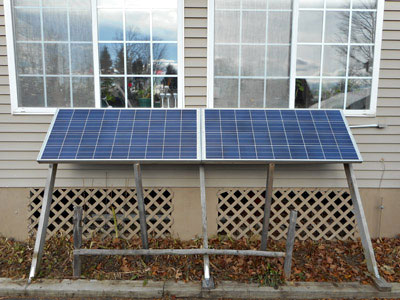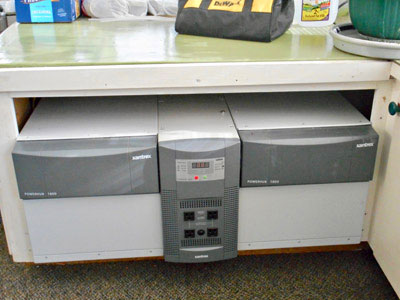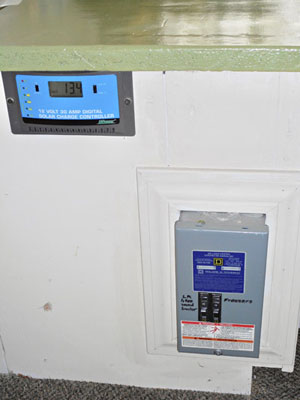 |
| Two 150 watt solar panels mounted on hinges allow easy seasonal adjustment of their angle to the sun. They are surprisingly responsive even to low light. Mounting at ground level means easy snow removal. The frame is hinged to large landscape timbers and can slide up the side of the house in case of frost heaves. |
 |
| My Xantrex solar “generator” with two battery boxes, located in a sun porch, is only 8 feet from the solar panels, thus reducing power loss in the low voltage line from panels to battery. |
 |
| The solar charge controller and circuit breakers are located on the end of the cabinet |
By Ben Hoffman
Photos by the author
When the power grid goes down, which it does several times a year – sometimes for three days or more – I need backup for my freezers and wood furnace. My wood gasification furnace needs a full charge of wood in the firebox, and the smoke and gases it generates burn in a refractory chamber at 1800 to 2000 degrees F. If the power goes off, the fans and secondary burn stop, but the wood in the firebox continues to burn and could seriously overheat my boiler.
I don’t like to store or burn gasoline or diesel, so a generator option was out. Once, in British Columbia, at 45 F below zero, the oil was too stiff to crank my generator. Solar was the answer – the fuel is free, safe, and emits no fumes. Many home solar installations in Maine are grid-tied so that owners generate enough juice to meet their needs and sell the surplus to the power company. But when the grid goes down, so do they. That’s not my idea of sustainability, so I bought a Xantrex system from Northern Tool for about $1,900. The package included two 150 watt solar panels and two 110 amp sealed AGM batteries – enough power to run my furnace until the fire burns out. It also powers two freezers, emergency lights and telephone. The control unit fits in the corner of my south-facing sun porch to protect it from temperature extremes and to minimize power losses in the low voltage line from the solar panels that are only 8 feet away. The Xantrex can also take a wind power input, and a small wind unit might be worthwhile on this windy ridge.
Rather than mount solar panels on the roof, I put them at ground level (Photo 1), close to the power unit. The frame is hinged to heavy landscape timbers, so frost heaving is not a problem. The panels are hinged to the frame, easily cleared of snow in winter, when sunlight is least, and the sun angle is adjusted with some props. Most people use 45 degrees at this latitude, but I use 75 in summer, 45 for fall and spring, and 15 in winter.
Some minor modification of basement wiring provided two circuits: one to the furnace and emergency lights, the other to the freezers. As a precaution I shut off the freezers (the largest load) when the grid goes down, as they will keep for two or three days if not opened. On sunny days I feed the freezers for a few hours to maintain their temperature and run a heavy-duty extension cord to my fridge. When the furnace fire dies, we heat with the kitchen wood stove.
The Xantrex predecessor was top notch and had a good reputation, but as entrepreneurs develop a good product, someone buys them out, and as those “someones” succeed, they are bought out. Each buyout equals a larger company with more interest in profit than pride in its product. A major component of my system, warranted for one year, failed after two years and could not be repaired, but Maine consumer law requires major appliances to have an implied warranty of four years, regardless of what the manufacturer says. A complaint to the Maine Attorney General’s office resulted in replacement with a new unit and an additional battery box.
The difference between an off-grid system and my setup (which is tied to the grid) is that an off-grid system has more solar panels and more, heavier, more expensive solar batteries that will last for four to eight years. My original two batteries handled several three-day outages with ease, but the windstorm of October 2017 maxed them after the third day, so I expanded the system to four batteries. You can’t mix new and old batteries. Deep cycle marine or golf cart batteries (about $100) might last two to three years but may not handle a major winter storm. An online search found reasonably priced ($200) 100 amp batteries.
My solar “generator” unit passes grid power to charge the batteries and meet loads from freezers, furnace or lights, but once the batteries are fully charged, it passes solar power to those loads. On sunny days when the panels really produce, solar power replaces the grid and saves $8 to $10 per month on my electric bill. That’s not much payback on my investment, but if grid power goes down, the batteries keep everything running – no noise, no fumes. Losing freezers full of food could cost more than the annual depreciation. Several neighbors have generators that require constant maintenance and gasoline, diesel or propane fuel that produces noxious fumes and noise.
I investigated every available product and concluded that Xantrex best met my needs, with the possible exception of SunRunr, a small Virginia company with a product made in the United States. The Xantrex will not handle a 220 volt deep well pump, but SunRunr probably would. SunRunr can also be independent of the grid.
If you are off the grid, solar is a good way to supply modest juice demands. You won’t need a solar “generator” (such as the Xantrex) but will need solar panels, batteries, a charge controller (which controls power to batteries) and an inverter (which converts 12 volt DC to 110 AC). A 12 or 24 volt system works for lighting, but power losses from low voltage DC are much higher than 110 AC. You can start with golf cart or deep cycle marine batteries to cut initial costs, but more expensive batteries last longer and can withstand heavy loads better.
YouTube has a lot of information about do-it-yourself solar, but much of the YouTube information is dangerous. The Xantrex manuals on installation and operation are complete, and with several years of electrical and electronic experience, I had no problem setting up the system myself. Installation and wiring are not rocket science, but be safe; if in doubt, get help. The solar panels should last for 30 years, the batteries up to eight and the control unit should be good for 10 years (but could die sooner.)
